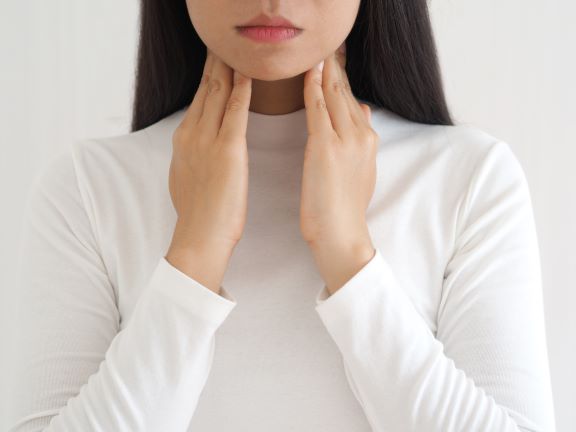Autoimmune Diseases and Dry Eye Disease
Our defense systems fight against diseases and infections by targeting harmful bacteria and viruses. An autoimmune condition occurs when the immune system somehow misidentifies specific body parts, such as skin, thyroid or joints, as foreign agents. Consequently, it mistakenly attacks our healthy cells causing inflammation, and in some cases, this may lead to chronic dry eyes.1
There are around 100 kinds of autoimmune diseases, that can affect almost any part of our body.2 It can be hard to diagnose an autoimmune disease because other illnesses and conditions may present similar symptoms, such as fatigue, joint pain, skin rash, abdominal pain, or recurring fever. Those symptoms may intensify temporarily during a flare‐up, then improve or vanish for some time.3
The autoimmune disorders reported to be associated with dry eye disease (DED) include type 1 diabetes mellitus, rheumatoid arthritis, psoriasis, systemic lupus erythematosus, Graves' disease, Sjögren's syndrome, Hashimoto's thyroiditis, and myasthenia gravis.4
Type 1 diabetes mellitus
Type 1 diabetes mellitus (T1DM) happens when the immune system attacks and destroys insulin‐producing cells. This disease is typically diagnosed in children and adolescents, which is why it was previously referred to as juvenile diabetes.
Individuals with T1DM are highly susceptible to developing meibomian gland dysfunction.5 The Meibomian glands are glands producing oily substances that form the outer layer of the tear film, preventing the tears from evaporating too quickly. Recent research has shown that some children with autoimmune diabetes have a higher prevalence of DED symptoms long before metabolic complications are anticipated.6 However, patients with long‐standing diabetes may experience reduced symptoms due to diabetic corneal neuropathy, a condition that reduces the sensitivity of the eye surface.7, 8 Therefore, it is necessary to conduct a thorough evaluation, even if minimal or no symptom is shown.

Rheumatoid arthritis
Rheumatoid arthritis (RA) is a chronic autoimmune disease that primarily affects the joints. The most frequent eye‐related complication of RA is dry eye, and RA is the most common autoimmune disorder that is linked to dry eye.9
Individuals who have had RA for a long time are more likely to experience severe dryness of the eyes compared to those who have recently developed the condition. The severity of dry eye is not associated with the activity level of RA, but rather its duration. Even patients with mild RA can experience dry eye, so individuals with RA should always be evaluated for dry eye regardless of the activity level of their RA.10
Psoriasis/psoriatic arthritis
Psoriasis (PsA) is a chronic autoimmune disease that stimulates the skin to increase the pace of its cellular growth cycle, resulting in raised, red, scaly patches on the skin. Psoriatic arthritis is a type of arthritis that arises in conjunction with psoriasis.
The dry eye symptoms are common in patients with psoriasis.11 Some studies show that approximately 19% of individuals with PsA develop ocular manifestations, and one of the causes of dry eye in psoriasis patients is the atrophy and dysfunction of the glands that secrete oil in the eye.12
Systemic lupus erythematosus (SLE)
Systemic lupus erythematosus (SLE) is a long‐term inflammatory condition that can impact the skin, joints, kidneys, blood cells, and nervous system. The disease can manifest in a variety of ways and can progress at different rates, ranging from slow and gradual to sudden and severe.13
Currently, it is widely accepted that dry eye syndrome in individuals with SLE is primarily due to secondary Sjögren's syndrome (sSS). However, there is growing evidence suggesting that dry eye syndrome and sSS may be independent conditions in patients with autoimmune diseases.14 Symptoms are usually mild and may include irritation and redness, but there is a possibility of experiencing severe pain and vision loss in some cases.
Graves' disease and Hashimoto's thyroiditis
Graves' disease and Hashimoto's thyroiditis are two types of thyroid conditions. In Graves' disease, there is an overproduction of thyroid hormones, while in Hashimoto's thyroiditis, these hormones are deficient. People with Graves' disease are more likely to experience eye issues, although individuals with Hashimoto's thyroiditis can also develop them.15

In the case of Graves' disease, along with the inflammation of the muscles and other tissues around the eyes, the eyelid may pull back more than usual, causing bulging eyes. These conditions can make it difficult to fully close the eyes, causing rapid moisture evaporation. Graves' disease usually affects both eyes, but sometimes one eye may be affected more than the other.16
Sjögren's syndrome
Sjögren's syndrome is a disorder that affects the areas of the body responsible for producing fluids such as tears and saliva. Over time, this can result in dryness of the eyes and mouth. The condition frequently occurs alongside other autoimmune disorders such as rheumatoid arthritis and lupus.17
Inflammation of the glands responsible for producing tears can decrease the amount of tears and the stability of tearfilm, leading to the development of dry eyes.18
Myasthenia gravis
Myasthenia gravis (MG) is an autoimmune condition that leads to the destruction of communication between nerves and muscles, causing weakness in the skeletal muscles.
MG can also affect the muscles responsible for controlling the eyes, resulting in visual impairments. When MG affects the eye muscles, it can result in various symptoms, such as drooping eyes, double vision, dry eyes, or trouble focusing. These symptoms tend to worsen towards the end of the day. Dry eye disease may develop in up to 21% of patients due to the inability to fully close their eyes and reduced blinking caused by weakened muscles located in the eyelids.19, 20
What are the treatments for dry eyes when you are coping with an autoimmune disease?
Sometimes treatments for autoimmune diseases also help your dry eyes, but patients often need separate treatments depending on the severity and the underlying condition. Some possible therapies include: 21
It's essential to promptly seek for medical advice if you're having autoimmunity and experiencing persistent dry eye symptoms.

- Autoimmune Diseases. Medline Plus. https://medlineplus.gov/autoimmunediseases.html (accessed 2023-02-28).
- Autoimmune Disease Basics. Global Autoimmune Institute. https://www.autoimmuneinstitute.org/autoimmune-disease-basics/ (accessed 2023- 02-28).
- Dry Eyes With Immune Disorders. WebMD. https://www.webmd.com/eyehealth/dry-eyes-immune-system-disorders (accessed 2023-02-28).
- What Causes Concurrent Dry Eyes and Dry Mouth? Healthline. https://www.healthline.com/health/dry-eyes-and-mouth (accessed 2023-02-28).
- Arunachalam, C. and Shamsheer R.P.. A clinical study of meibomian gland dysfunction in patients with diabetes. Middle East African Journal of Ophthalmology 2015;22(4): 462–466.
- Akinci, A., et al. Dry Eye Syndrome in Diabetic Children. European Journal of Ophthalmology 2018;17(6):873-878.
- Guzel, B., et al. Diabetic corneal neuropathy: clinical perspectives. Clinical Ophthalmology 2018;12:981-987.
- Zhang, X., et al. Dry Eye Syndrome in Patients with Diabetes Mellitus: Prevalence, Etiology, and Clinical Characteristics. Journal of Ophthalmology 2016;2016:1-7.
- Evren Kemer, O. Dry Eye in Rheumatoid Arthritis. International Ophthalmology Clinics. 2017;57(2):89-99.
- Abd-Allah, N.M., et al. Dry eye in rheumatoid arthritis: relation to disease activity. Immunological Medicine. 2020;43(2):92-97.
- Her, Y., et al. Dry eye and tear film functions in patients with psoriasis. Japanese Journal of Ophthalmology. 2013;57(4):341-346.
- Taheri, A.R., et al. The study of dry eye and meibomian glands in psoriasis. European Journal of Ophthalmology. 2021;32(2): 853-858.
- Systemic Lupus Erythematosus (SLE). Medscape. https://emedicine.medscape.com/article/332244-overview (accessed 2023-02-28).
- Chen, A., et al. Severity of dry eye syndrome is related to anti-dsDNA autoantibody in systemic lupus erythematosus patients without secondary Sjogren syndrome. Medicine. 2016;95(28):e4218.
- Kan, E., et al. Presence of Dry Eye in Patients with Hashimoto's Thyroiditis. Journal of Ophthalmology. 2014;2014:754923.
- Graves' Eye Disease. National Eye Institute. https://www.nei.nih.gov/learn-abouteye-health/eye-conditions-and-diseases/graves-eye-disease (accessed 2023-02-28).
- What you need to know about Sjogren's Syndrome. Lupus Foundation of America. https://www.lupus.org/resources/what-you-need-to-know-about-sjogrens-syndrome (accessed 2023-02-28).
- Dry Eye. Sjögren's foundation. https://sjogrens.org/understandingsjogrens/symptoms/dry-eye (accessed 2023-02-28).
- Roh, H.S., et al. Comparison of Clinical Manifestations between Patients with Ocular Myasthenia Gravis and Generalized Myasthenia Gravis. Korean Journal of Ophthalmology. 2011;25(1):1-7.
- Maintaining Eye Health with Myasthenia Gravis. Myasthenia-Gravis.com. https://myasthenia-gravis.com/clinical/eye-health (accessed 2023-02-28).
- Dry Eye - Diagnosis and treatment. Mayo Clinic. https://www.mayoclinic.org/diseases-conditions/dry-eyes/diagnosis-treatment/drc20371869 (accessed 2023-02-28).
Five‐item Dry Eye Questionnaire (DEQ-5).
관련 게시물
Five‐item Dry Eye Questionnaire (DEQ-5).
Five‐item Dry Eye Questionnaire (DEQ-5).









